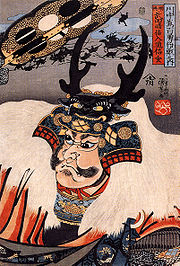
Koyo Gunkan
Encyclopedia

Takeda family
The ' was a famous clan of daimyō in Japan's late Heian Period to Sengoku period.The Takeda were descendants of Emperor Seiwa and are a branch of the Minamoto clan , by Minamoto no Yoshimitsu , brother to the Chinjufu-shogun Minamoto no Yoshiie...
, compiled largely by the Takeda vassal Kōsaka Danjō Masanobu
Kosaka Masanobu
also known as was one of Takeda Shingen's most loyal retainers, and one of his "Twenty-Four Generals" during the Sengoku period of Japan. He is often credited as the original author of Kōyō Gunkan, which records the history of the Takeda family and their military tactics...
, and completed in 1616 by Obata Kagenori
Obata Kagenori
Obata Kagenori , also known as Obata Dōgyū, was a Confucian scholar and samurai retainer of the Takeda clan during Japan's Sengoku period...
. It provides some of the most detailed descriptions and statistics of warfare in the Sengoku period
Sengoku period
The or Warring States period in Japanese history was a time of social upheaval, political intrigue, and nearly constant military conflict that lasted roughly from the middle of the 15th century to the beginning of the 17th century. The name "Sengoku" was adopted by Japanese historians in reference...
available today.
The chronicle describes each of the Takeda's major battles, chronicling not only strategy and tactics but the outcomes as well. It describes the Chinese matchlock arquebus
Arquebus
The arquebus , or "hook tube", is an early muzzle-loaded firearm used in the 15th to 17th centuries. The word was originally modeled on the German hakenbüchse; this produced haquebute...
es used at Uedahara
Battle of Uedahara
The was the first defeat suffered by Takeda Shingen, and the first field battle in Japan at which firearms were used.Takeda Shingen met up with his force that had taken Shika castle, and led 7000 men north to face the threat posed by Murakami Yoshikiyo...
in 1548, making that the first field battle in Japan to see the use of firearms. And the chronicle tells of the famous one-on-one skirmish fought by Takeda Shingen
Takeda Shingen
, of Kai Province, was a preeminent daimyo in feudal Japan with exceptional military prestige in the late stage of the Sengoku period.-Name:Shingen was called "Tarō" or "Katsuchiyo" during his childhood...
against Uesugi Kenshin
Uesugi Kenshin
was a daimyo who ruled Echigo province in the Sengoku period of Japan.He was one of the most powerful lords of the Sengoku period. While chiefly remembered for his prowess on the battlefield, Kenshin is also regarded as an extremely skillful administrator who fostered the growth of local industries...
at the fourth battle of Kawanakajima
Battles of Kawanakajima
The ' were fought in the Sengoku Period of Japan between Takeda Shingen of Kai Province and Uesugi Kenshin of Echigo Province in the plain of Kawanakajima, in the north of Shinano Province. The location is in the southern part of the present-day city of Nagano.The five major battles took place in...
in 1561. Having broken through Takeda's forces, Uesugi Kenshin found his way to Shingen's command tent, where he engaged Shingen directly, slashing at him with his sword. Shingen deflected the attack with his iron war fan, and reached for his own sword. A Takeda retainer then speared Kenshin's horse, forcing him to retreat.
In one section, the chronicle gives a detailed breakdown of the entire Takeda army in 1573, counting everything from pages
Page (servant)
A page or page boy is a traditionally young male servant, a messenger at the service of a nobleman or royal.-The medieval page:In medieval times, a page was an attendant to a knight; an apprentice squire...
and banner bearers
Nobori
', literally meaning 'banner', had a more specific meaning on the battlefields of feudal Japan. It referred to a particular type of banner denoting units within an army; nobori became much more common in the Sengoku period, coming into use alongside the earlier hata-jirushi...
to kitchen staff, horse doctors, and finance commissioners. According to the document, the 33,736 members of the Takeda army included 9121 horsemen, 18,242 followers for the horsemen, 884 ashigaru
Ashigaru
The Japanese ashigaru were foot-soldiers of medieval Japan. The first known reference to ashigaru was in the 1300s, but it was during the Ashikaga Shogunate-Muromachi period that the use of ashigaru became prevalent by various warring factions.-Origins:Attempts were made in Japan by the Emperor...
(foot-soldiers) within the hatamoto shoyakunin (personal attendants to the lord), and 5489 other ashigaru. The detailed breakdown of the army also provides an interesting look into the hierarchy of retainers or allies within such a force.
The Heihō Okigusho, contained within the chronicle, and attributed to general Yamamoto Kansuke
Yamamoto Kansuke
was a Japanese samurai of the 16th century who was one of Takeda Shingen's most trusted Twenty-Four Generals. Also known by his formal name, Haruyuki . He was a brilliant strategist, and is particularly known for his plan which led to victory in the fourth battle of Kawanakajima against Uesugi...
, is one of Japan's earliest treatises on martial arts, along with tactics and strategy. It provides practical advice towards the wielding of sword, spear, gun and bow for the individual warrior rather than for the strategy of an entire troop. Sections by Kosaka Masanobu express his views on the warrior code in relation to the connection between lord and vassal. He compares Shingen to the ideal lord, and contrasts him to his son Takeda Katsuyori
Takeda Katsuyori
was a Japanese daimyo of the Sengoku Period, who was famed as the head of the Takeda clan and the successor to the legendary warlord Takeda Shingen. He was the son of Shingen by the , the daughter of Suwa Yorishige...
, whose poor leadership quickly led to the downfall of the clan.

